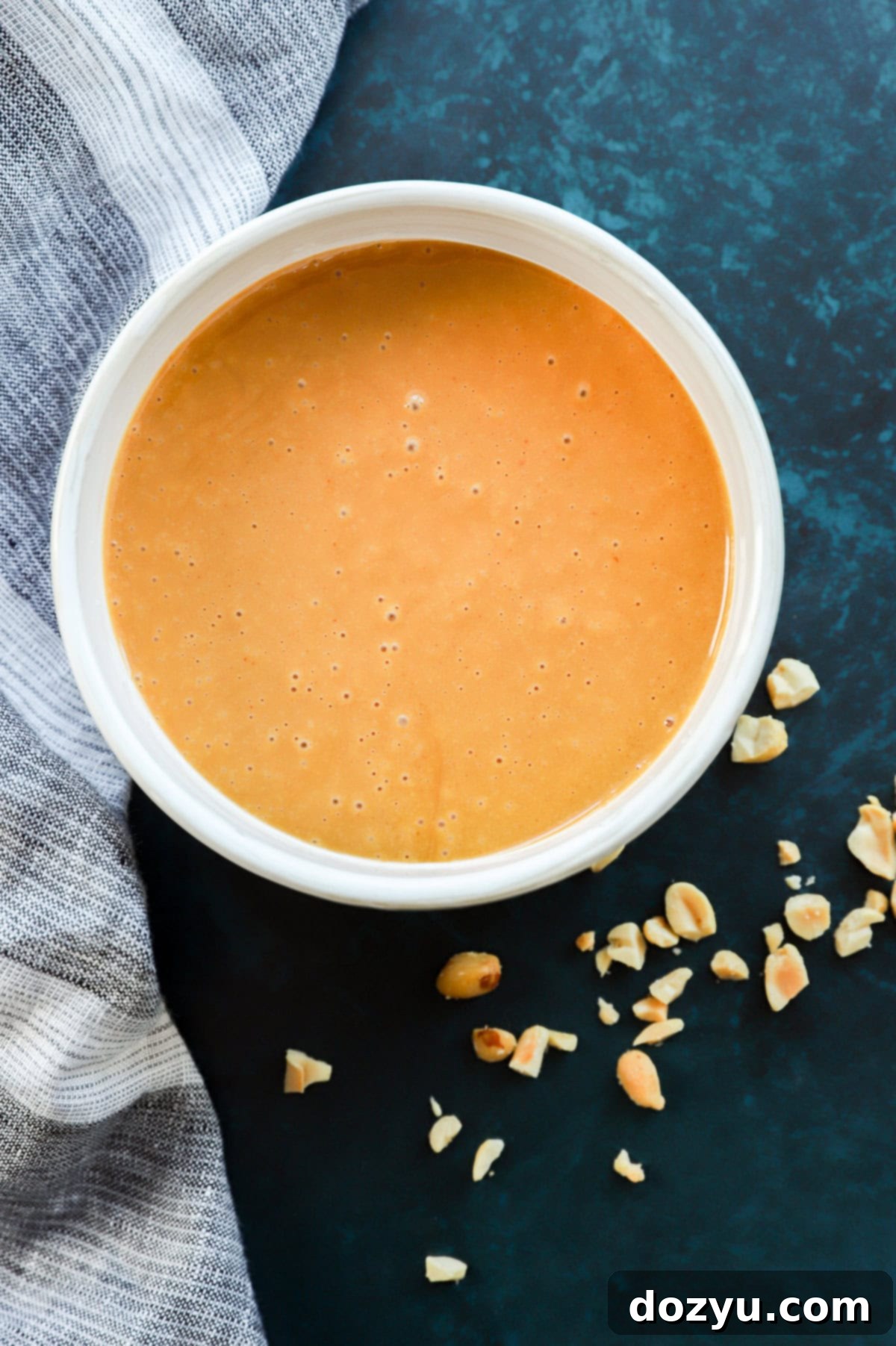Unleash Flavor: Your Guide to Making the Best Homemade Thai Peanut Dressing
Say goodbye to bland meals and hello to a burst of vibrant flavor with this incredible homemade Thai peanut dressing. It’s incredibly simple to prepare, yet delivers a complex profile of sweet, savory, tangy, and a hint of spice. This versatile dressing is an absolute game-changer, perfect for elevating everything from crisp salads and grilled chicken to hearty Buddha bowls and fresh spring rolls. Made with just a handful of readily available ingredients, you’ll wonder how you ever lived without it.
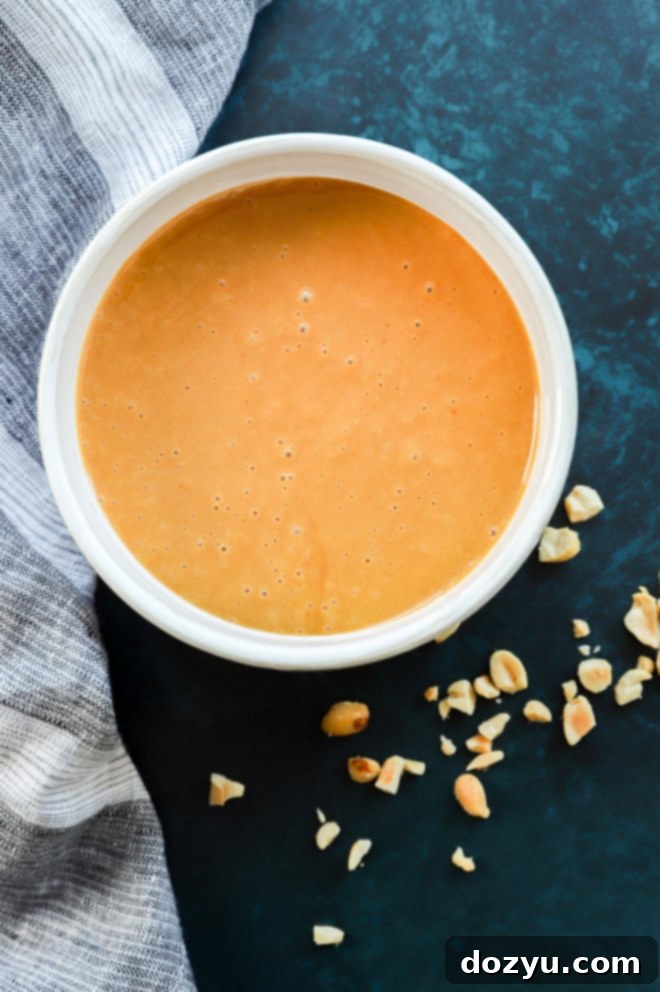
Table of Contents
Toggle
About This Homemade Thai Peanut Dressing
For many, enjoying a salad truly hinges on the quality of the dressing. It’s not enough for it to be merely acceptable; it needs to be extraordinary. It should be the kind of dressing that makes you eagerly anticipate your next forkful, whether it’s coating fresh greens, complementing proteins, or even enjoyed straight from the spoon. Essentially, a truly great dressing inspires cravings for wholesome vegetables and exciting flavors.
This homemade Thai peanut dressing perfectly embodies that spirit. It’s a harmonious blend of creamy richness, bright tanginess, and a subtle yet satisfying kick of spice that leaves your taste buds singing. Forget the mundane and predictable vinaigrettes; this dressing offers a dynamic flavor profile that transforms any dish into an exciting culinary adventure.
I initially developed this recipe out of a desire for something more exciting than the usual salad options. Now, it has become a staple in my refrigerator, consistently proving its worth with its incredible versatility. While it’s an obvious choice for salads, its applications extend far beyond. Imagine it as a delectable dipping sauce for crispy spring rolls, a savory drizzle over succulent grilled chicken, or a rich, creamy sauce for noodles. Its unique balance of flavors makes it compatible with a wide array of ingredients and cooking styles.
While this dressing might not solve all of life’s complex problems, it promises to inject a much-needed dose of excitement into your everyday meals. It’s a simple, affordable way to bring gourmet Asian-inspired flavors into your home, making your lunch breaks and dinner routines noticeably more enjoyable. And honestly, a little extra joy at mealtime is always a good thing, isn’t it?
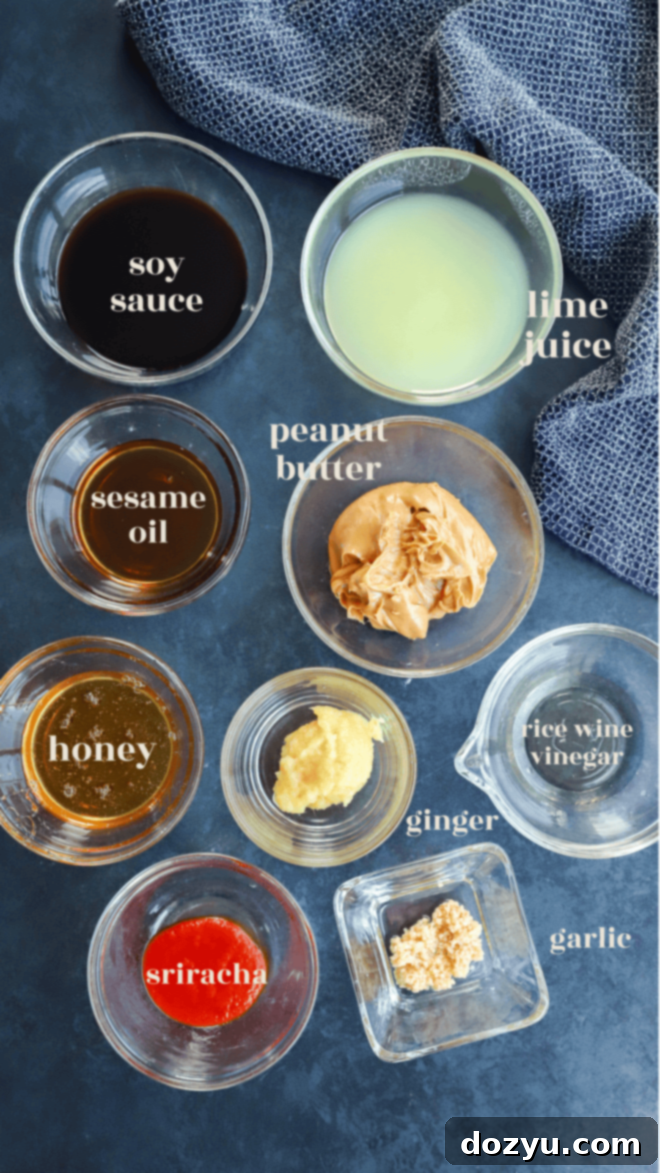
Key Ingredients for Thai Peanut Sauce
Crafting the perfect Thai peanut dressing relies on a balance of fresh, high-quality ingredients. Each component plays a crucial role in building the dressing’s signature complex flavor:
- Ginger: This root adds a zesty, pungent, and slightly spicy flavor that is essential to Asian cuisine. You can use convenient store-bought ginger paste or, for the freshest taste, grate a peeled knob of fresh ginger using a microplane or fine grater. Fresh ginger provides an unparalleled aromatic kick.
- Garlic: A foundational flavor builder, garlic provides a pungent, savory depth. Whether you opt for pre-minced garlic for convenience or finely mince fresh garlic cloves yourself, ensure it’s fresh for the best impact.
- Peanut Butter: The star of the show! Creamy peanut butter creates the rich, smooth base for this dressing. While any creamy brand works, a natural peanut butter (without added sugars or oils) can offer a purer peanut flavor. Avoid crunchy peanut butter unless you desire a textured dressing, but for smooth results, creamy is key.
- Lime Juice: Freshly squeezed lime juice is non-negotiable for that bright, tangy lift that cuts through the richness of the peanut butter. It adds a crucial citrusy note that balances the entire dressing. Bottled lime juice simply won’t offer the same vibrant flavor.
- Soy Sauce: This provides the deep umami and savory saltiness. We often recommend low-sodium soy sauce to better control the overall saltiness of the dressing, allowing you to season to taste. For a gluten-free alternative, Tamari or coconut aminos work perfectly, maintaining a similar savory profile.
- Honey: Our preferred sweetener for its subtle floral notes and rich sweetness. Honey perfectly complements the savory elements. If you’re looking for vegan options, pure maple syrup or agave nectar are excellent substitutes, though they may impart a slightly different, yet still delicious, flavor.
- Toasted Sesame Oil: A little goes a long way with toasted sesame oil. Its distinctive nutty and deeply aromatic flavor adds an incredible layer of complexity and authentic Asian essence to the dressing. Be sure to use toasted sesame oil for that rich, unmistakable aroma.
- Vinegar: Red wine vinegar offers a wonderfully sharp and slightly fruity acidity that brilliantly balances the rich and savory ingredients. Alternatively, rice vinegar (also known as rice wine vinegar) is a common choice in Asian-inspired dressings, providing a milder, slightly sweeter acidity.
- Sriracha: For that signature spicy kick, Sriracha is our go-to. It adds a pleasant heat without overpowering the other flavors. Adjust the amount according to your preference for spice, or use your favorite hot sauce.
- Salt and Pepper: Essential for seasoning! Kosher salt and freshly cracked black pepper are added to taste, allowing you to fine-tune the dressing to your exact preference. Remember to taste and adjust after blending.
Essential Equipment for Your Dressing
While this Thai peanut dressing recipe is incredibly straightforward, having the right tools can make the process even smoother and quicker. You’ll need basic kitchen essentials like measuring cups and measuring spoons to ensure accurate ingredient proportions, which are key for achieving the perfect flavor balance.
For truly effortless preparation, a high-speed blender, such as a Vitamix, is highly recommended. It quickly emulsifies all the ingredients into a perfectly smooth and creamy consistency in just a minute or two. If you don’t have a high-speed blender, a standard blender will also work, though you might need to blend for a bit longer and scrape down the sides occasionally. A food processor is another excellent alternative that will achieve similarly smooth results, especially if your peanut butter is on the thicker side. The goal is to create a well-combined, uniform sauce, so choose the appliance that best suits your kitchen.
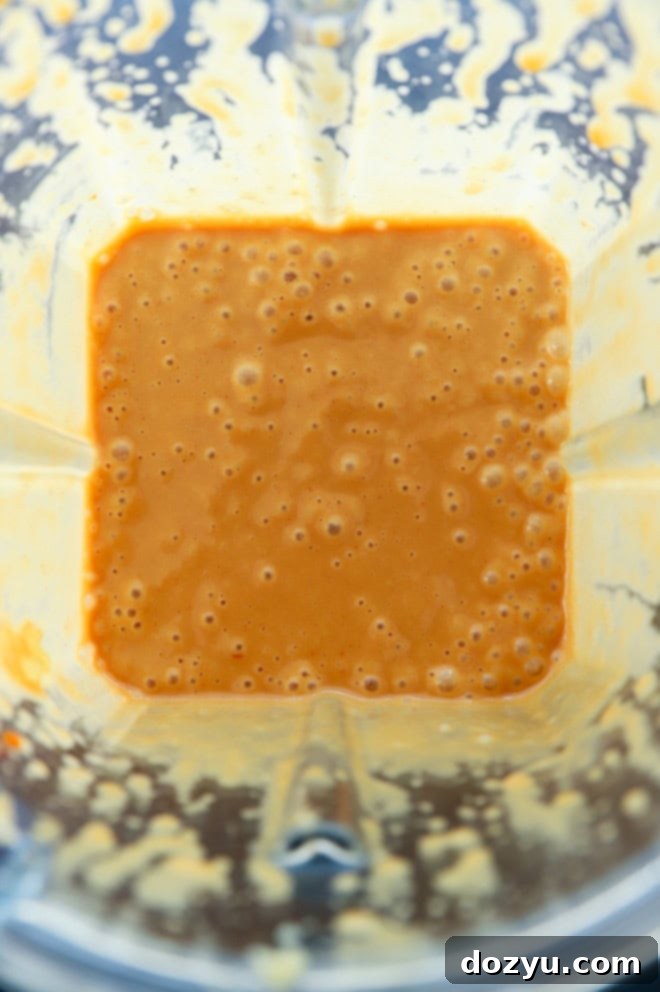
How to Whip Up Thai Peanut Dressing
Making this incredible Thai peanut dressing is unbelievably quick and easy. With just a few simple steps, you’ll have a flavorful sauce ready to enhance any meal.
Blend to Perfection
Begin by gathering all your ingredients. Add the grated ginger (or ginger paste), minced garlic, creamy peanut butter, fresh lime juice, soy sauce, honey (or your chosen alternative sweetener like agave or maple syrup), toasted sesame oil, rice wine vinegar, and Sriracha to your blender. It’s best to add the liquids first, then the thicker ingredients, to help the blades catch everything properly. Blend all these ingredients until the mixture is completely smooth and wonderfully creamy. There should be no lumps, and the color should be uniform.
Once blended, it’s crucial to taste and adjust. This is where you truly make the dressing your own. Add salt and freshly cracked black pepper to taste. If it needs more tang, add a touch more lime juice or vinegar. For extra sweetness, another swirl of honey. And for a bolder kick, a dash more Sriracha will do the trick. Blend again briefly after each adjustment to incorporate fully.
Properly Store Your Dressing
This freshly blended Thai peanut dressing can be used immediately to dress your favorite salads, marinate proteins, or as a dipping sauce. If you have any leftovers, or prefer to make it ahead of time, simply transfer the dressing to an airtight container. Store it in the refrigerator for optimal freshness, where it will last beautifully for up to 4 days. Before each use, give it a good stir or a quick shake, as some separation of ingredients is natural over time.
Customize Your Thai Peanut Dressing: Variations
One of the best things about making your own dressing is the ability to customize it to your exact preferences. Here are some popular variations to try:
- Make it Spicier: If you love a fiery kick, feel free to increase the amount of Sriracha in the recipe. Start by adding an extra half teaspoon and taste before adding more. For an even more intense heat and a slight textural contrast, a pinch of red pepper flakes can be blended in or stirred at the end.
- Make it Thicker: For a denser, more substantial dressing that’s perfect for spreading on sandwiches or coating noodles, simply add an additional 2 to 3 tablespoons of peanut butter to the blender. If it becomes too thick, you can thin it out with a teaspoon or two of water, vegetable broth, or extra lime juice until it reaches your desired consistency.
- Don’t Forget to Season to Taste! This cannot be stressed enough. Ingredients can vary in potency, so always taste your dressing after it’s blended. Adjust the salt and pepper as needed. You might also find it needs a bit more sweetness, tang, or heat to perfectly match your palate. A balanced dressing is a delicious dressing!
- Add a Citrus Boost: If you want to enhance the citrusy freshness, consider adding a teaspoon of lime zest along with the juice. The oils in the zest provide an aromatic lift.
- Herbaceous Notes: For an extra layer of flavor, fresh cilantro or a few mint leaves can be blended into the dressing. These herbs complement the Thai profile beautifully.
Craving more delicious homemade sauces? You’ll love these: Garlic Aioli | Chipotle Aioli | Bang Bang Sauce | Roasted Garlic Aioli | Classic Caesar Dressing
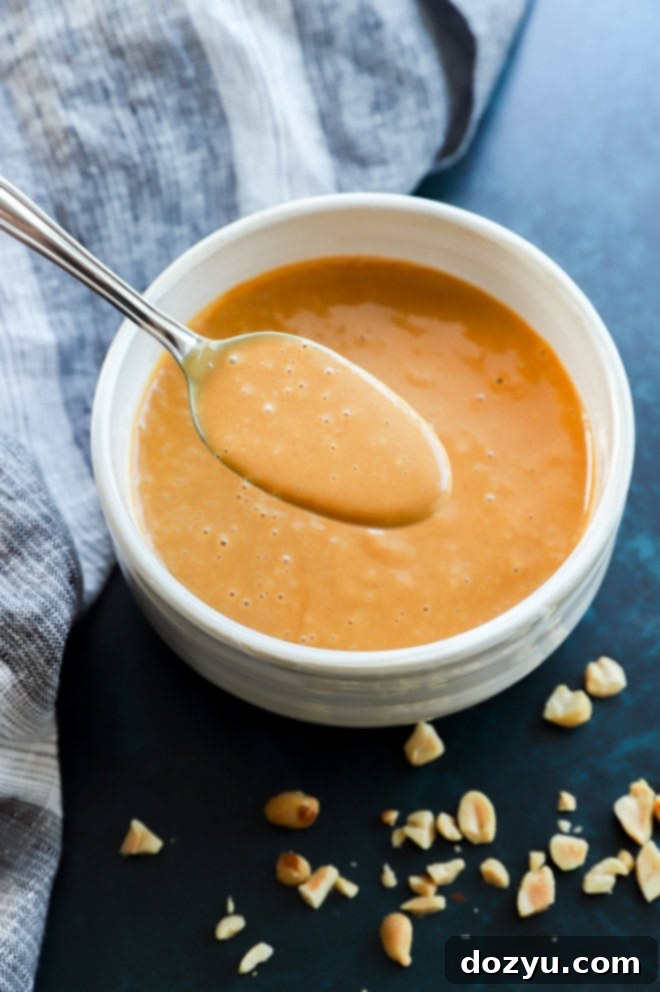
Can I Substitute Peanut Butter with Another Nut Butter?
Absolutely! While traditional Thai peanut dressing, as the name suggests, uses peanut butter, this recipe is highly adaptable. You can easily transform this into a different nutty sauce by swapping out the peanut butter for an alternative nut butter. Almond butter or cashew butter are excellent choices. Keep in mind that the flavor profile will naturally shift; almond butter tends to be slightly milder, while cashew butter offers a creamier, subtly sweeter taste. Hazelnut butter could also be an interesting, albeit less conventional, option for a unique twist.
When making this substitution, always choose creamy, unsweetened, and unsalted varieties of nut butter to best control the final flavor. You might find that you need to adjust other ingredients slightly (like sweetness or salt) to achieve your preferred balance, as different nut butters have varying natural sweetness and salt levels. The core components of tang, spice, and umami will still shine through, giving you a delicious, customized dressing.
Making Your Thai Peanut Dressing Vegan
Making this delectable Thai peanut dressing suitable for a vegan diet is incredibly simple. The only non-vegan ingredient in the original recipe is honey. To create a fully vegan version, all you need to do is swap out the honey for an alternative plant-based sweetener.
Excellent vegan alternatives include agave nectar or pure maple syrup. Both provide the necessary sweetness and blend seamlessly into the dressing. It’s worth noting that using these alternatives may subtly alter the overall flavor profile; maple syrup, for example, has a distinct taste that might be detectable. Therefore, it’s always recommended to taste the dressing after blending and adjust the seasonings as desired. You might find you want a touch more lime for brightness or Sriracha for heat to achieve your perfect vegan Thai peanut dressing.
How Long Does Homemade Thai Peanut Dressing Last?
Proper storage is key to enjoying your homemade Thai peanut dressing for as long as possible. When stored correctly, this dressing will maintain its freshness, flavor, and creamy consistency in the refrigerator for up to 4 days. To ensure it stays fresh, always transfer the dressing to an airtight container or a tightly sealed mason jar immediately after preparation.
Before each use, it’s a good idea to give the container a vigorous shake or stir the dressing with a spoon, as some natural separation of ingredients, especially the oil and peanut butter, can occur over time. This re-emulsifies the dressing, bringing it back to its original creamy texture. Beyond 4 days, while it might still be safe to consume, the quality, vibrancy of flavor, and texture may start to diminish.
Looking for more sweet inspiration? Explore my collection of dessert recipes!
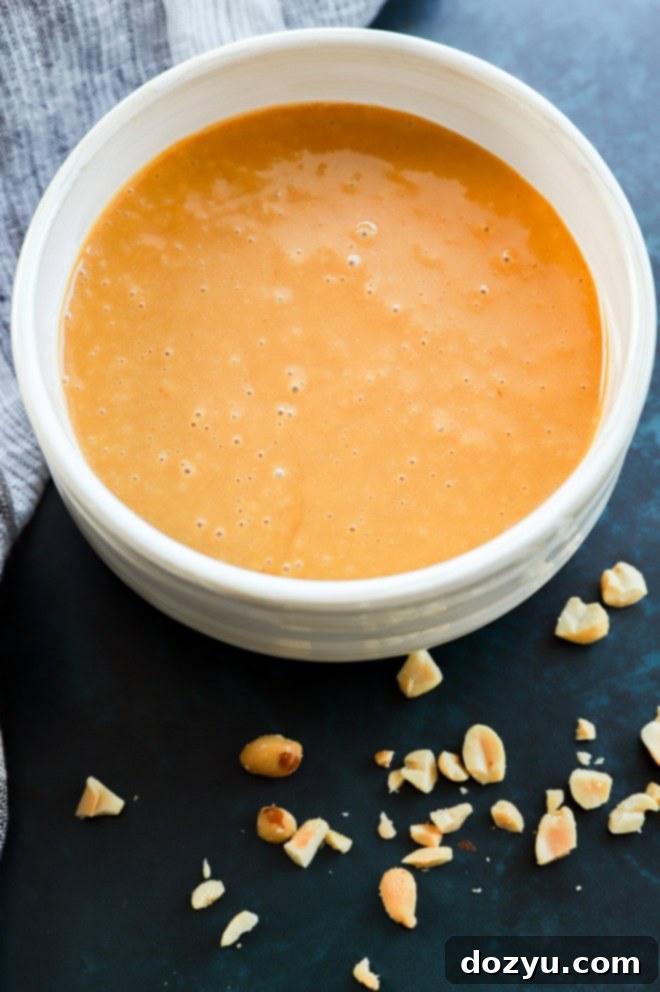
Creative Ways to Use Thai Peanut Dressing
This homemade Thai peanut dressing is incredibly versatile and can be incorporated into a multitude of dishes beyond just salads. Its rich, tangy, and slightly spicy flavor profile makes it a fantastic addition to both Asian-inspired meals and everyday favorites. Here are some fantastic ideas to help you get the most out of your freshly made dressing:
- Classic Salad Dressing: The most obvious, yet incredibly delicious, use. Drizzle generously over your favorite mixed green salads, noodle salads, or even grain bowls. It pairs wonderfully with crunchy vegetables like bell peppers, shredded carrots, cucumber, and cabbage.
- Irresistible Dipping Sauce: Elevate your appetizer game by using this dressing as a dipping sauce. It’s absolutely perfect for fresh Vietnamese spring rolls, crispy egg rolls, steamed wontons, grilled skewers (chicken, beef, or tofu), or even simple raw vegetable sticks.
- Flavorful Sandwich Spread or Wrap Filler: Spread a thin layer on your sandwiches or wraps for an unexpected, exciting flavor boost. It works beautifully with grilled chicken, turkey, or even a vegetarian hummus and veggie wrap, adding a creamy, savory, and slightly sweet element.
- Thai-Inspired Pasta Salad Base: Transform your ordinary pasta salad into a vibrant Thai delight. Toss cooked and cooled pasta with the peanut dressing, along with fresh vegetables like bell peppers, snap peas, shredded carrots, cilantro, and scallions. Add some crushed peanuts for extra crunch!
- Marinade or Glaze for Proteins: Use it as a marinade for chicken, pork, beef, or tofu before grilling, baking, or pan-frying. The dressing helps tenderize and infuse the protein with incredible flavor. You can also drizzle it over cooked proteins as a finishing sauce, adding a gourmet touch to simple grilled dishes.
- Noodle Bowl Sauce: Create quick and easy noodle bowls by tossing warm or cold noodles with the dressing, then adding your favorite cooked protein and plenty of fresh, crisp vegetables. Garnish with chopped peanuts and cilantro.
- Stir-Fry Sauce: While it’s a thicker dressing, you can thin it slightly with a tablespoon or two of water or broth to create a quick and flavorful stir-fry sauce. Add it in during the last few minutes of cooking your stir-fry for a rich finish.
- Buddha Bowl Enhancement: The dressing is a perfect component for Buddha bowls. Combine your favorite grains (quinoa, rice), roasted vegetables, fresh greens, and a protein source, then finish with a generous drizzle of this peanut dressing for a cohesive and delicious meal.
Storage Tips for Freshness
To keep your homemade Thai peanut dressing at its best, proper storage is crucial. After preparing, transfer the dressing into a clean, airtight container or a glass mason jar with a tight-fitting lid. This prevents air exposure, which can degrade flavor and freshness. Store the container in the refrigerator. The dressing will remain fresh and delicious for up to 4 days. If you notice any separation of ingredients (which is natural with homemade dressings), simply give it a good shake or stir vigorously before each use to restore its creamy consistency. Always use clean utensils when serving to avoid contamination and extend its shelf life.
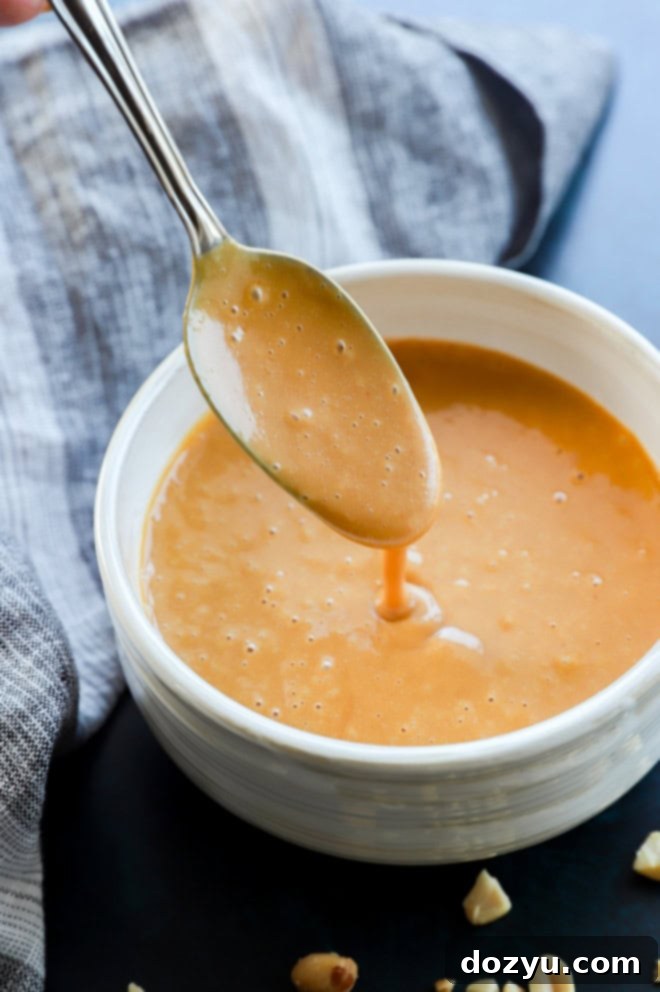
Explore More Thai-Inspired Recipes
If you’re loving the flavors of this Thai peanut dressing, you’ll definitely want to explore more Thai-inspired dishes. These recipes perfectly complement the vibrant and aromatic profile of Thai cuisine:
- This hearty yet light Thai shrimp noodle soup features a rich red curry and tomato base, offering a comforting and flavorful meal that satisfies without being too heavy.
- For a truly delicious appetizer, my Thai turkey avocado egg rolls are a must-try! They boast a perfectly crispy exterior and are packed with an incredible blend of flavors inside. They are especially delightful when paired with this homemade Thai peanut dressing as a dipping sauce.
- Bring that beloved nutty flavor to your next side dish with a crunchy Thai pasta salad. This vibrant salad is loaded with fresh vegetables and tossed in a savory dressing, making it a fantastic addition to any meal or a light lunch on its own.
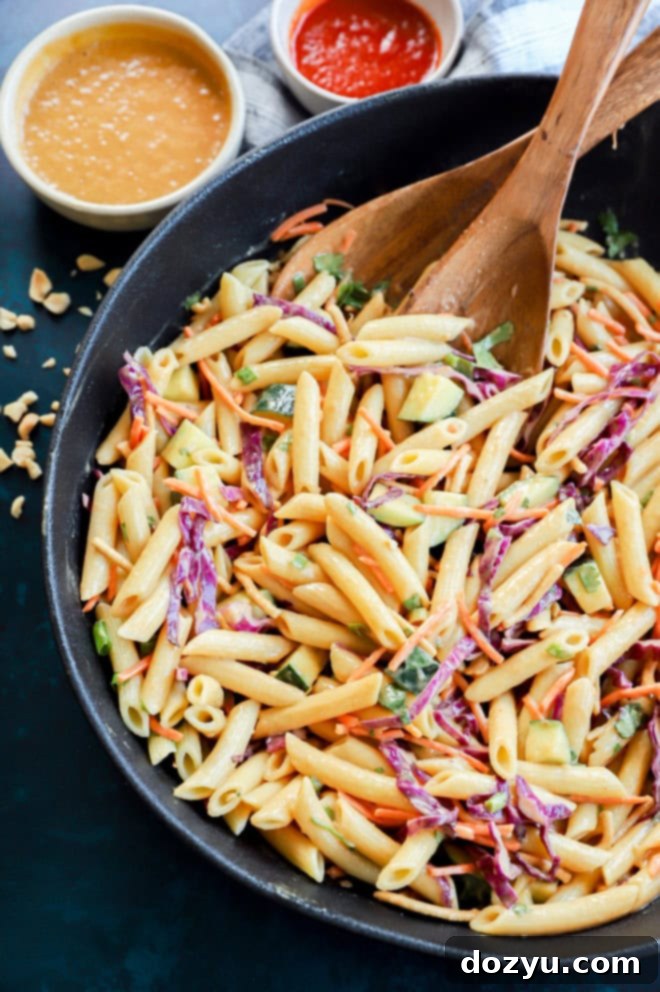
Finally, if you take the time to make this incredible Thai peanut salad dressing recipe, please be sure to give this recipe a star rating on the recipe card below and/or leave a comment sharing your experience! Your feedback is invaluable, and I genuinely love hearing from you all and take the time to respond to every single comment. Don’t hesitate to drop any questions you might have in the comments section as well!
Oh, and make sure to tag me on Instagram, Facebook, or Pinterest if you share your culinary creations! Seeing these recipes come to life in your homes is truly my favorite thing, and I adore looking through all your photos. It means the world to me!
Want to stay updated with new recipes, kitchen tips, and the latest news? Be sure to sign up for my newsletter for exclusive content and updates straight to your inbox!
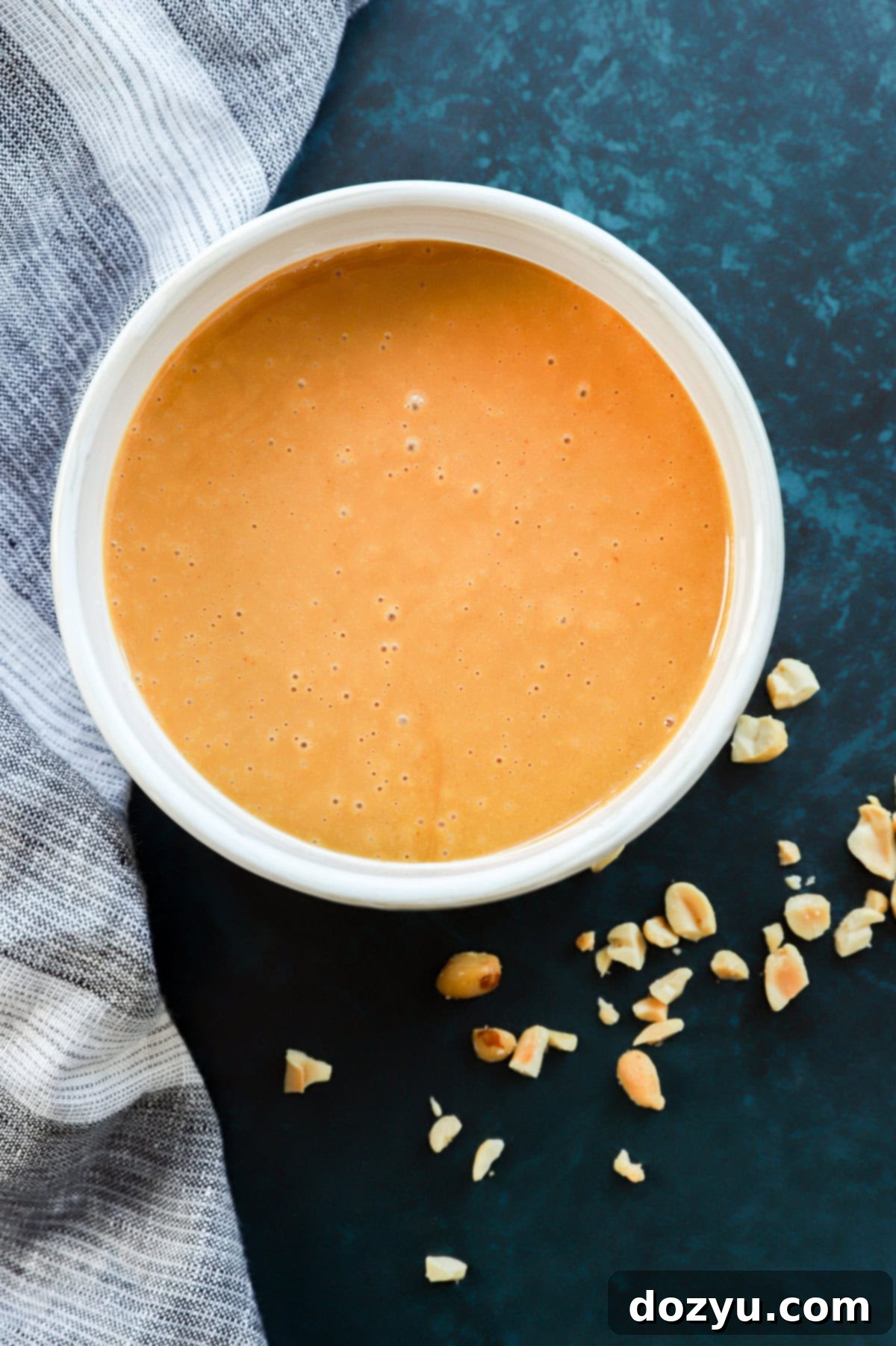
Thai Peanut Dressing
Recommended Equipment
-
Measuring Cups
-
Measuring Spoons
-
High-Speed Blender (e.g., Vitamix)
Ingredients
- 1 Tbsp ginger paste or finely grated fresh ginger
- 2 cloves garlic minced or pressed
- 1/2 cup creamy peanut butter natural, unsweetened recommended
- 1/3 cup fresh lime juice about 2-3 limes
- 1/3 cup low-sodium soy sauce or Tamari for gluten-free
- 1/4 cup honey or maple syrup/agave for vegan
- 1/4 cup toasted sesame oil
- 1 Tbsp rice wine vinegar or red wine vinegar
- 2 tsp Sriracha adjust to your spice preference
- 1/4 tsp kosher salt + more to taste
- Freshly cracked black pepper to taste
Instructions
-
Add all of the listed ingredients (ginger, garlic, peanut butter, lime juice, soy sauce, honey/sweetener, sesame oil, vinegar, Sriracha, and initial salt) to a high-speed blender or food processor.
-
Blend until the mixture is completely smooth and creamy. Ensure there are no lumps of peanut butter or ginger/garlic remaining. Scrape down the sides if necessary to ensure even blending.
-
Taste the dressing and adjust seasonings as desired. Add more salt, freshly cracked black pepper, Sriracha for heat, or lime juice for tang, until it perfectly suits your palate. Blend briefly after each adjustment.
-
Serve immediately over your favorite dishes, or transfer to an airtight container and store in the refrigerator for up to 4 days. Shake or stir well before each use.
Recipe Video
Nutrition Facts
